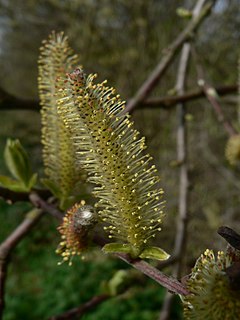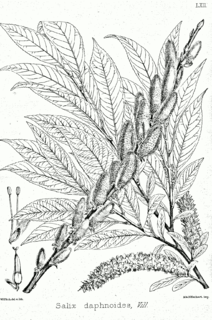
Willows, also called sallows and osiers, form the genus Salix, around 400 species of deciduous trees and shrubs, found primarily on moist soils in cold and temperate regions of the Northern Hemisphere. Most species are known as willow, but some narrow-leaved shrub species are called osier, and some broader-leaved species are referred to as sallow. Some willows are low-growing or creeping shrubs; for example, the dwarf willow rarely exceeds 6 cm (2.4 in) in height, though it spreads widely across the ground.

Southwick Beach State Park is a New York State park that lies along an unusual stretch of sandy beach on the eastern shore of Lake Ontario. The park is 464 acres (188 ha) in size with a 3,500 foot (1,100 m) length of beach, and is visited annually by about 100,000 people. Immediately to the south is the Lakeview Wildlife Management Area, which extends the publicly accessible beach by several miles. They are in the Town of Ellisburg in Jefferson County, New York south of the lakeside community of Jefferson Park.

Salix purpurea is a species of willow native to most of Europe and western Asia north to the British Isles, Poland, and the Baltic States.

Salix fragilis, with the common names crack willow and brittle willow, is a species of willow native to Europe and Western Asia. It is native to riparian habitats, usually found growing beside rivers and streams, and in marshes and water meadow channels.

Salix viminalis, the basket willow, common osier or osier, is a species of willow native to Europe, Western Asia, and the Himalayas.

Salix cinerea is a species of willow native to Europe and western Asia.

Salix nigra, the black willow, is a species of willow native to eastern North America, from New Brunswick and southern Ontario west to Minnesota, and south to northern Florida and Texas.

Ammophila breviligulata is a species of grass native to eastern North America, where it grows on sand dunes along the Atlantic Ocean and Great Lakes coasts. Beachgrass thrives under conditions of shifting sand, sand burial, and high winds; it is a dune-building grass that builds the first line of sand dunes along the coast. Beachgrass is less vigorous in stabilized sand, and is only infrequently found further inland than the coastal foredunes. On the Atlantic coastline of North America, Ammophila breviligulata has been observed as far south as North Carolina, and is often planted in dune restoration projects. Ammophila breviligulata was introduced to the Pacific coast of North America in the 1930s. It is proving to be invasive, and is increasingly important to coastal ecology and development in Oregon, Washington, and British Columbia.

Salix lucida, the shining willow, Pacific willow, or whiplash willow, is a species of willow native to northern and western North America, occurring in wetland habitats.

The Athabasca Sand Dunes Provincial Park was created to protect the Athabasca sand dunes, a unique geophysical land feature in the boreal shield ecosystem of the province of Saskatchewan. The Athabasca Sand Dunes are one of the most northerly active sand dune formations on Earth.

Salix triandra, with the common names almond willow or almond-leaved willow, is a species of willow native to Europe and Western and Central Asia. It is found from south-eastern England east to Lake Baikal, and south to Spain and the Mediterranean east to the Caucasus, and the Alborz Mountains. It usually grows in riparian habitats, on river and stream banks, and in wetlands.

Salix hookeriana is a species of willow known by the common names dune willow, coastal willow, and Hooker's willow.

Salix sitchensis is a species of willow known by the common name Sitka willow.

Salix brachycarpa is a species of flowering plant in the willow family known by the common names barren-ground willow, small-fruit willow and shortfruit willow.

Salix eleagnos the bitter willow, olive willow, hoary willow, rosemary willow, or elaeagnus willow, is a species of flowering plant in the family Salicaceae, native to central and southern Europe and south west Asia. Growing to 3 m (10 ft) tall by 5 m (16 ft) broad, it is an erect bushy deciduous shrub with narrow grey-green leaves up to 20 cm (8 in) long, which turn yellow in autumn (fall). The green catkins, 3–6 cm (1–2 in) long, appear with the leaves in spring, male catkins having yellow anthers.
Salix columbiana, the Columbia River willow, is a species of willow known only from the US states of Washington and Oregon. It grows on dunes, floodplains and riverbanks, many of these locales being located near the Columbia River.
Salix petrophila, commonly known as alpine willow and Rocky Mountain willow, is a Northwest American mountain shrub in the willow family (Salicaceae).

Salix repens, the creeping willow, is a small, shrubby species of willow in the family Salicaceae, growing up to 1.5 metres in height. Found amongst sand dunes and heathlands, it is a polymorphic species, with a wide range of variants. In the UK, at least, these range from small, prostrate, hairless plants at one end of the spectrum to taller, erect or ascending silky-leaved shrubs at the other. This wide variation in form has resulted in numerous synonyms.

Salix daphnoides or European violet willow is a species of plant in the family Salicaceae. It can grow as a large shrub or small tree, normally reaching a height of between 6 and 8 metres, but can grow up to 12 metres tall.

















